金融时间序列分析 第3部分 Matlab时间序列分析 01
Matlab时间序列分析在金融领域的应用
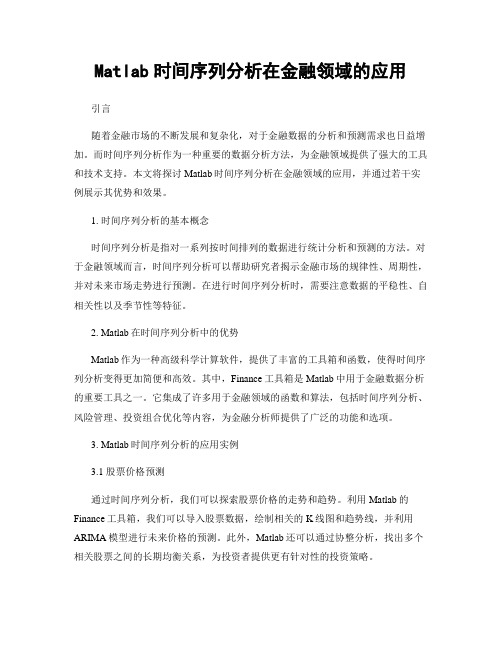
Matlab时间序列分析在金融领域的应用引言随着金融市场的不断发展和复杂化,对于金融数据的分析和预测需求也日益增加。
而时间序列分析作为一种重要的数据分析方法,为金融领域提供了强大的工具和技术支持。
本文将探讨Matlab时间序列分析在金融领域的应用,并通过若干实例展示其优势和效果。
1. 时间序列分析的基本概念时间序列分析是指对一系列按时间排列的数据进行统计分析和预测的方法。
对于金融领域而言,时间序列分析可以帮助研究者揭示金融市场的规律性、周期性,并对未来市场走势进行预测。
在进行时间序列分析时,需要注意数据的平稳性、自相关性以及季节性等特征。
2. Matlab在时间序列分析中的优势Matlab作为一种高级科学计算软件,提供了丰富的工具箱和函数,使得时间序列分析变得更加简便和高效。
其中,Finance工具箱是Matlab中用于金融数据分析的重要工具之一。
它集成了许多用于金融领域的函数和算法,包括时间序列分析、风险管理、投资组合优化等内容,为金融分析师提供了广泛的功能和选项。
3. Matlab时间序列分析的应用实例3.1 股票价格预测通过时间序列分析,我们可以探索股票价格的走势和趋势。
利用Matlab的Finance工具箱,我们可以导入股票数据,绘制相关的K线图和趋势线,并利用ARIMA模型进行未来价格的预测。
此外,Matlab还可以通过协整分析,找出多个相关股票之间的长期均衡关系,为投资者提供更有针对性的投资策略。
3.2 市场波动性分析金融市场的波动性是投资者关注的另一个重要指标。
通过时间序列分析,我们可以计算和预测市场的波动性水平,并提供相应的风险管理策略。
Matlab中的ARCH和GARCH模型提供了一种常用的方法,可以帮助研究者对金融产品的波动性进行建模和预测。
3.3 交易策略优化时间序列分析还可以应用于交易策略的优化和回测。
通过分析历史交易数据,结合技术指标和市场走势,我们可以利用Matlab开发各种交易算法,并通过模拟回测和优化参数来评估其效果和风险。
使用MATLAB进行时间序列分析的基本原理

使用MATLAB进行时间序列分析的基本原理导言:时间序列分析是一种重要的数据分析方法,可以帮助我们理解数据随时间变化的模式和趋势。
而MATLAB作为一种功能强大的编程语言和数据分析工具,提供了丰富的函数和工具包来支持时间序列分析。
本文将介绍使用MATLAB进行时间序列分析的基本原理和方法。
一、时间序列概述时间序列是一系列按照时间顺序排列的连续观测值的集合。
时间序列常见于金融、经济、气象、医学等领域,可以用来描述某个变量随时间变化的趋势、周期性和随机性。
时间序列分析旨在从历史数据中提取有用的信息,预测未来的趋势和行为。
二、MATLAB环境下的时间序列数据处理在MATLAB中,我们可以使用Time Series对象来处理时间序列数据。
Time Series对象可以包含时间序列数据和对应的时间信息,提供了一系列函数和方法来进行数据处理和分析。
接下来,将介绍一些常用的时间序列数据处理方法。
1. 数据导入和可视化首先,可以使用MATLAB的导入数据工具箱将时间序列数据从文件中导入到MATLAB环境中,如CSV、Excel或文本文件等格式。
然后,可以使用plot函数将时间序列数据可视化,观察数据的趋势和周期性。
2. 数据平滑和去趋势在时间序列分析中,我们常常需要对数据进行平滑处理,以减少随机波动的影响,更好地观察数据的趋势。
MATLAB提供了多种平滑方法,如移动平均、指数平滑和Loess平滑等。
此外,可以使用detrend函数对时间序列数据进行去趋势操作,去除长期趋势的影响。
3. 数据周期性分析周期性是时间序列数据中重要的特征之一。
MATLAB中的FFT函数可以将时域数据转换为频域数据,从而可以进行频谱分析和周期分析。
通过观察频谱图,可以发现数据中的主要周期和周期成分。
4. 数据预测时间序列分析的一个重要应用是进行数据预测。
MATLAB提供了多种时间序列模型,如自回归移动平均模型(ARMA)、自回归积分滑动平均模型(ARIMA)和季节性自回归积分滑动平均模型(SARIMA)等。
MATLAB中的时间序列分析方法
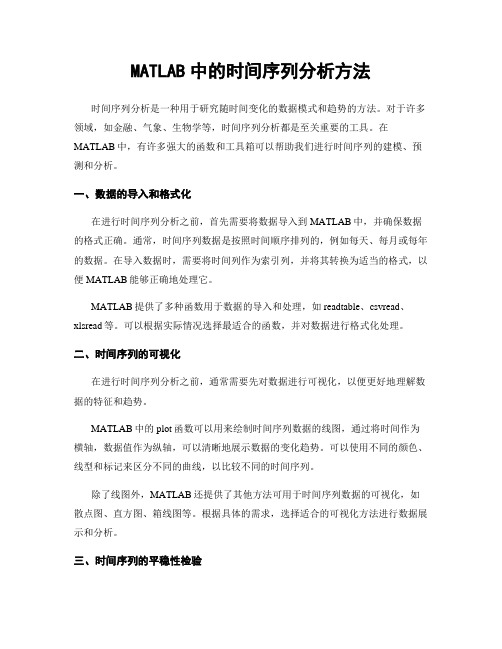
MATLAB中的时间序列分析方法时间序列分析是一种用于研究随时间变化的数据模式和趋势的方法。
对于许多领域,如金融、气象、生物学等,时间序列分析都是至关重要的工具。
在MATLAB中,有许多强大的函数和工具箱可以帮助我们进行时间序列的建模、预测和分析。
一、数据的导入和格式化在进行时间序列分析之前,首先需要将数据导入到MATLAB中,并确保数据的格式正确。
通常,时间序列数据是按照时间顺序排列的,例如每天、每月或每年的数据。
在导入数据时,需要将时间列作为索引列,并将其转换为适当的格式,以便MATLAB能够正确地处理它。
MATLAB提供了多种函数用于数据的导入和处理,如readtable、csvread、xlsread等。
可以根据实际情况选择最适合的函数,并对数据进行格式化处理。
二、时间序列的可视化在进行时间序列分析之前,通常需要先对数据进行可视化,以便更好地理解数据的特征和趋势。
MATLAB中的plot函数可以用来绘制时间序列数据的线图,通过将时间作为横轴,数据值作为纵轴,可以清晰地展示数据的变化趋势。
可以使用不同的颜色、线型和标记来区分不同的曲线,以比较不同的时间序列。
除了线图外,MATLAB还提供了其他方法可用于时间序列数据的可视化,如散点图、直方图、箱线图等。
根据具体的需求,选择适合的可视化方法进行数据展示和分析。
三、时间序列的平稳性检验在进行时间序列分析时,一个重要的假设是时间序列数据的平稳性。
平稳性是指时间序列的均值、方差和自协方差在时间上保持不变的性质。
如果时间序列不是平稳的,那么在建立模型和进行预测时,可能会导致误差和偏差。
MATLAB中的adftest函数可以用来进行平稳性检验。
该函数基于单位根检验方法,通过比较单位根检验统计量和临界值,判断时间序列的平稳性。
如果p值小于置信水平(通常为0.05),则可以拒绝原假设,认为时间序列是平稳的。
四、时间序列的分解时间序列通常由趋势、季节性和随机项组成。
使用Matlab进行时间序列分析的基本步骤
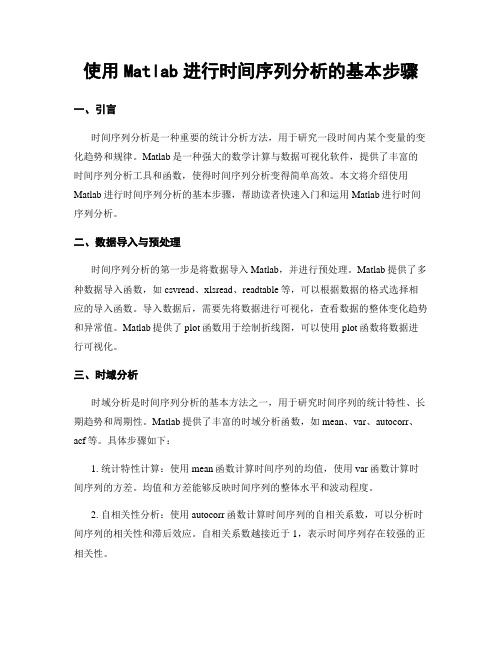
使用Matlab进行时间序列分析的基本步骤一、引言时间序列分析是一种重要的统计分析方法,用于研究一段时间内某个变量的变化趋势和规律。
Matlab是一种强大的数学计算与数据可视化软件,提供了丰富的时间序列分析工具和函数,使得时间序列分析变得简单高效。
本文将介绍使用Matlab进行时间序列分析的基本步骤,帮助读者快速入门和运用Matlab进行时间序列分析。
二、数据导入与预处理时间序列分析的第一步是将数据导入Matlab,并进行预处理。
Matlab提供了多种数据导入函数,如csvread、xlsread、readtable等,可以根据数据的格式选择相应的导入函数。
导入数据后,需要先将数据进行可视化,查看数据的整体变化趋势和异常值。
Matlab提供了plot函数用于绘制折线图,可以使用plot函数将数据进行可视化。
三、时域分析时域分析是时间序列分析的基本方法之一,用于研究时间序列的统计特性、长期趋势和周期性。
Matlab提供了丰富的时域分析函数,如mean、var、autocorr、acf等。
具体步骤如下:1. 统计特性计算:使用mean函数计算时间序列的均值,使用var函数计算时间序列的方差。
均值和方差能够反映时间序列的整体水平和波动程度。
2. 自相关性分析:使用autocorr函数计算时间序列的自相关系数,可以分析时间序列的相关性和滞后效应。
自相关系数越接近于1,表示时间序列存在较强的正相关性。
3. 自相关函数绘制:使用acf函数绘制时间序列的自相关函数图,可以可视化时间序列的自相关性。
通过观察自相关函数图,可以发现时间序列的周期性和滞后效应。
四、频域分析频域分析是时间序列分析的另一个重要方法,用于研究时间序列的频率成分和周期性。
Matlab提供了多种频域分析函数,如fft、pwelch、periodogram等。
具体步骤如下:1. 傅里叶变换:使用fft函数对时间序列进行傅里叶变换,将时间序列转换为频域信号。
Matlab金融工具箱的使用指南
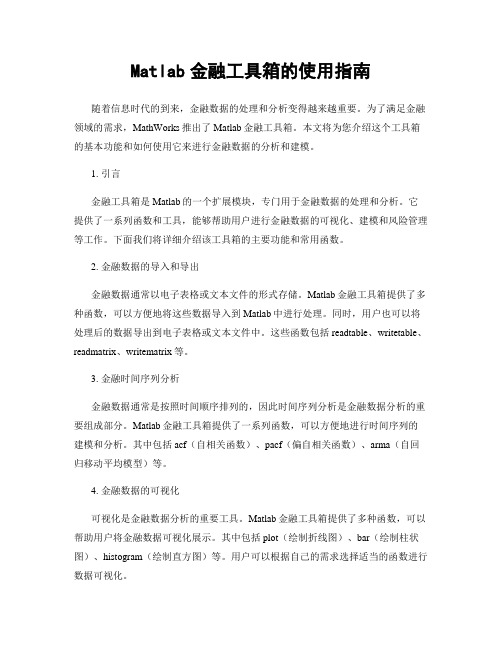
Matlab金融工具箱的使用指南随着信息时代的到来,金融数据的处理和分析变得越来越重要。
为了满足金融领域的需求,MathWorks推出了Matlab金融工具箱。
本文将为您介绍这个工具箱的基本功能和如何使用它来进行金融数据的分析和建模。
1. 引言金融工具箱是Matlab的一个扩展模块,专门用于金融数据的处理和分析。
它提供了一系列函数和工具,能够帮助用户进行金融数据的可视化、建模和风险管理等工作。
下面我们将详细介绍该工具箱的主要功能和常用函数。
2. 金融数据的导入和导出金融数据通常以电子表格或文本文件的形式存储。
Matlab金融工具箱提供了多种函数,可以方便地将这些数据导入到Matlab中进行处理。
同时,用户也可以将处理后的数据导出到电子表格或文本文件中。
这些函数包括readtable、writetable、readmatrix、writematrix等。
3. 金融时间序列分析金融数据通常是按照时间顺序排列的,因此时间序列分析是金融数据分析的重要组成部分。
Matlab金融工具箱提供了一系列函数,可以方便地进行时间序列的建模和分析。
其中包括acf(自相关函数)、pacf(偏自相关函数)、arma(自回归移动平均模型)等。
4. 金融数据的可视化可视化是金融数据分析的重要工具。
Matlab金融工具箱提供了多种函数,可以帮助用户将金融数据可视化展示。
其中包括plot(绘制折线图)、bar(绘制柱状图)、histogram(绘制直方图)等。
用户可以根据自己的需求选择适当的函数进行数据可视化。
5. 金融数据的建模和预测建模和预测是金融数据分析的核心工作。
Matlab金融工具箱提供了多种经典的建模和预测方法,帮助用户进行金融数据的建模和预测。
其中包括线性回归模型、ARMA模型、GARCH模型等。
用户可以使用这些函数来分析和预测金融市场的走势。
6. 风险管理与投资组合优化风险管理对于金融机构和投资者至关重要。
Matlab金融工具箱提供了一系列函数和工具,可以帮助用户进行风险管理和投资组合优化。
如何使用Matlab技术进行时间序列分析
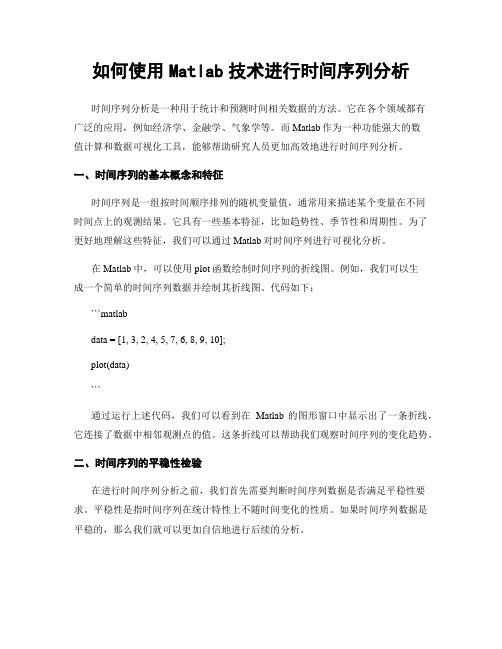
如何使用Matlab技术进行时间序列分析时间序列分析是一种用于统计和预测时间相关数据的方法。
它在各个领域都有广泛的应用,例如经济学、金融学、气象学等。
而Matlab作为一种功能强大的数值计算和数据可视化工具,能够帮助研究人员更加高效地进行时间序列分析。
一、时间序列的基本概念和特征时间序列是一组按时间顺序排列的随机变量值,通常用来描述某个变量在不同时间点上的观测结果。
它具有一些基本特征,比如趋势性、季节性和周期性。
为了更好地理解这些特征,我们可以通过Matlab对时间序列进行可视化分析。
在Matlab中,可以使用plot函数绘制时间序列的折线图。
例如,我们可以生成一个简单的时间序列数据并绘制其折线图。
代码如下:```matlabdata = [1, 3, 2, 4, 5, 7, 6, 8, 9, 10];plot(data)```通过运行上述代码,我们可以看到在Matlab的图形窗口中显示出了一条折线,它连接了数据中相邻观测点的值。
这条折线可以帮助我们观察时间序列的变化趋势。
二、时间序列的平稳性检验在进行时间序列分析之前,我们首先需要判断时间序列数据是否满足平稳性要求。
平稳性是指时间序列在统计特性上不随时间变化的性质。
如果时间序列数据是平稳的,那么我们就可以更加自信地进行后续的分析。
Matlab中有多种方法用于判断时间序列的平稳性。
其中一种常用的方法是ADF检验(Augmented Dickey-Fuller test)。
它的原假设是时间序列具有单位根(非平稳)的特性。
在Matlab中,可以使用adftest函数进行ADF检验。
例如,我们可以使用一个具有趋势的时间序列数据进行平稳性检验。
代码如下:```matlabdata = [1, 2, 3, 4, 5, 6, 7, 8, 9, 10];[h, pValue, stat, cValue] = adftest(data);```通过运行上述代码,我们可以得到h值,用来判断时间序列是否为平稳的。
MATLAB中常见的时间序列分析技巧
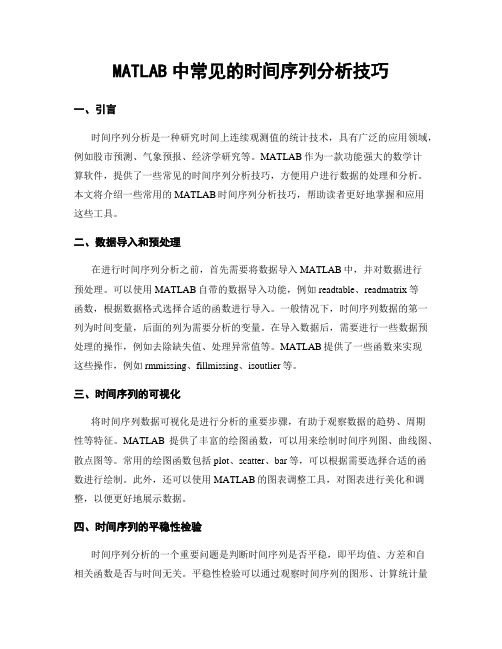
MATLAB中常见的时间序列分析技巧一、引言时间序列分析是一种研究时间上连续观测值的统计技术,具有广泛的应用领域,例如股市预测、气象预报、经济学研究等。
MATLAB作为一款功能强大的数学计算软件,提供了一些常见的时间序列分析技巧,方便用户进行数据的处理和分析。
本文将介绍一些常用的MATLAB时间序列分析技巧,帮助读者更好地掌握和应用这些工具。
二、数据导入和预处理在进行时间序列分析之前,首先需要将数据导入MATLAB中,并对数据进行预处理。
可以使用MATLAB自带的数据导入功能,例如readtable、readmatrix等函数,根据数据格式选择合适的函数进行导入。
一般情况下,时间序列数据的第一列为时间变量,后面的列为需要分析的变量。
在导入数据后,需要进行一些数据预处理的操作,例如去除缺失值、处理异常值等。
MATLAB提供了一些函数来实现这些操作,例如rmmissing、fillmissing、isoutlier等。
三、时间序列的可视化将时间序列数据可视化是进行分析的重要步骤,有助于观察数据的趋势、周期性等特征。
MATLAB提供了丰富的绘图函数,可以用来绘制时间序列图、曲线图、散点图等。
常用的绘图函数包括plot、scatter、bar等,可以根据需要选择合适的函数进行绘制。
此外,还可以使用MATLAB的图表调整工具,对图表进行美化和调整,以便更好地展示数据。
四、时间序列的平稳性检验时间序列分析的一个重要问题是判断时间序列是否平稳,即平均值、方差和自相关函数是否与时间无关。
平稳性检验可以通过观察时间序列的图形、计算统计量以及进行单位根检验等方法来完成。
MATLAB提供了一些函数来进行平稳性检验,例如adftest、kpsstest等。
使用这些函数可以方便地进行平稳性检验,并根据检验结果进行相应的数据处理和模型选择。
五、时间序列的预测建模时间序列的预测建模是进行时间序列分析的关键步骤之一。
MATLAB提供了一些函数来进行时间序列的建模和预测,例如arima、forecast等。
金融时间序列分析__Matlab时间序列分析

Copulas重要理解
❖ Sklar(1959)定理:
▪ 对于多元分布H,F、G为边际分布,则C函数存在, 且唯一。
▪ C(u,v), u=F(x), v=G(y) ▪ u,v: (0,1)2, C:(0,1) ▪ Farlie–Gumbel–Morgenstern family copulas
❖ 若X,Y相互独立,则C=uv ❖ 若Y是X的确定函数,则
p207
❖ A static conditional mean model: ▪ the ordinary linear regression model.
❖ A dynamic conditional mean model
arima class
❖ model objects for stationary, or unit-root nonstationary linear time series models.
❖ includes
①moving average (MA), ②autoregressive (AR), ③mixed autoregressive and moving average
(ARMA), ④integrated (ARIMA), ⑤multiplicative seasonal models.
▪ Determining Dependence Between Simulation Inputs ▪ Constructing Dependent Bivariate Distributions ▪ Using Rank Correlation Coefficients ▪ Using Bivariate Copulas ▪ Higher Dimension Copulas ▪ Archimedean Copulas ▪ Simulating Dependent Multivariate Data Using
Matlab金融计算讲义

收盘价
36
35
34
33
ห้องสมุดไป่ตู้
32
2013/01
2013/02
2013/03 日期
2013/04
2013/05
(3)fetch函数 从网络获取股票数据(Yahoo、Bloomberg) c=yahoo;%从雅虎获取数据 x=fetch(c,'security_name','fields','fromedate', 'todate','period'); security:证券的名字(代号) fields可取close,high,volume period可取d,w,m,v,分别表示日、周、月、 红利
1.1 时间序列变量的创立
1.1.1 fints函数创立时间变量序列 Matlab中有专门的时间序列格式来保存时间 序列数据。命令为fints(dates, data)。第一列为时 间,其他列为相应的数据。 例1-1 文件:fts_ex01.m 程序:dates=[today:today+5]'; data=[1:6]'; tsobjkt = fints(dates, data)
例1-6 利用例5中的数据,用MA模型 进行估计。 文件:fts_ex06.m
例1-7 利用青岛啤酒和沪深300指数2012年5月2 日至2013年5月21日的日收盘价收益率,用 ARMAX模型进行估计。 文件:fts_ex07.m
(3)广义线性模型PEM 调用方式: sys=pem(data,’na’,na,’nb’,nb,’nc’,nc,’nd’, nd,’nf ’,nf,’nk’,nk) (4)Box-Jenkins模型 调用方式: sys=bj(data,’nb’,nb,’nc’,nc,’nd’,nd,’nf ’,nf,’nk’,nk)
Matlab中的时间序列分析方法介绍

Matlab中的时间序列分析方法介绍时间序列分析是一种重要的数据分析技术,它用于研究随时间变化的数据。
在众多数据分析工具中,Matlab是一个强大且广泛使用的软件包。
本文将介绍Matlab中的时间序列分析方法及其应用。
一、时间序列分析概述时间序列分析是研究随时间变化的现象,通过对过去的观测结果进行分析,以预测未来的变化趋势。
在金融、经济学、气象学等领域,时间序列分析都具有重要的应用价值。
Matlab提供了丰富的函数和工具箱,用于执行各种时间序列分析任务。
二、时间序列表示与可视化在进行时间序列分析之前,首先需要了解如何表示和可视化时间序列数据。
在Matlab中,时间序列数据可以是一个矢量、矩阵或表格。
常见的时间序列数据类型包括日期格式、时间戳和时间间隔。
1.日期格式:Matlab中使用datetime数据类型表示日期和时间。
可以使用datetime函数创建日期数组,通过设置日期格式可以灵活地处理不同的时间序列数据。
2.时间戳:时间戳是一种用于表示某个特定时间点的数字形式。
在Matlab中,可以使用datenum函数将日期、时间转换为时间戳,或者使用datestr函数将时间戳转换为可读的日期格式。
3.时间间隔:时间间隔表示两个时间点之间的距离。
在Matlab中,duration函数可以用于表示时间间隔,而days、hours、minutes、seconds等函数则用于执行时间单位之间的转换。
完成时间序列数据的表示之后,可以使用plot函数将数据可视化。
Matlab提供了丰富的绘图函数和选项,可以创建各种类型的图形,如折线图、散点图、柱状图等。
三、时间序列预处理在进行时间序列分析之前,通常需要对数据进行一些预处理操作,以去除噪声、平滑数据、填补缺失值等。
1.噪声去除:时间序列数据常常包含噪声成分,干扰了对数据真实趋势的分析。
Matlab提供了一系列滤波函数,如lowpass、highpass、bandpass等,可以用于去除数据中的噪声成分。
Matlab中的时间序列分析技巧

Matlab中的时间序列分析技巧时间序列分析是一种用于统计和经济数据分析的重要方法。
而Matlab作为一种强大的数值计算和数据分析工具,提供了丰富的函数和工具箱来支持时间序列分析。
本文将介绍一些在Matlab中进行时间序列分析的常用技巧和方法。
一、基本概念和预处理技巧时间序列是按照时间顺序排列的一组数据,通常用于描述随时间变化的现象。
在进行时间序列分析之前,首先需要了解一些基本概念和预处理技巧。
1.1 平稳性检验平稳性是指时间序列的统计特性在不同时间段上保持不变,它是进行时间序列分析的基本假设之一。
在Matlab中,可以通过函数adftest来进行平稳性检验。
该函数基于ADF(Augmented Dickey-Fuller)检验,若检验结果的p值小于0.05,则可以认为序列是平稳的。
1.2 数据差分对于非平稳时间序列,可以通过差分操作将其转化为平稳序列。
在Matlab中,可以使用函数diff来进行一阶差分操作。
例如,对于序列y,可以使用y_diff =diff(y)来得到差分序列。
1.3 季节性调整如果时间序列中存在明显的季节性变化,可以使用季节性调整技术来剔除季节性影响,从而分析序列的长期趋势。
在Matlab中,可以使用函数seasonaladjust来进行季节性调整。
二、时间序列建模和预测时间序列建模是指根据已有的时间序列数据,通过拟合统计模型来描述和预测序列的未来趋势。
Matlab提供了多种模型来进行时间序列建模和预测。
2.1 ARIMA模型ARIMA(AutoRegressive Integrated Moving Average)模型是一种广泛应用于时间序列建模和预测的方法。
在Matlab中,可以使用函数arima来拟合ARIMA模型。
2.2 GARCH模型GARCH(Generalized Autoregressive Conditional Heteroscedasticity)模型是一种用于建模和预测金融时间序列波动的方法。
Matlab中的时间序列处理方法与实例分析
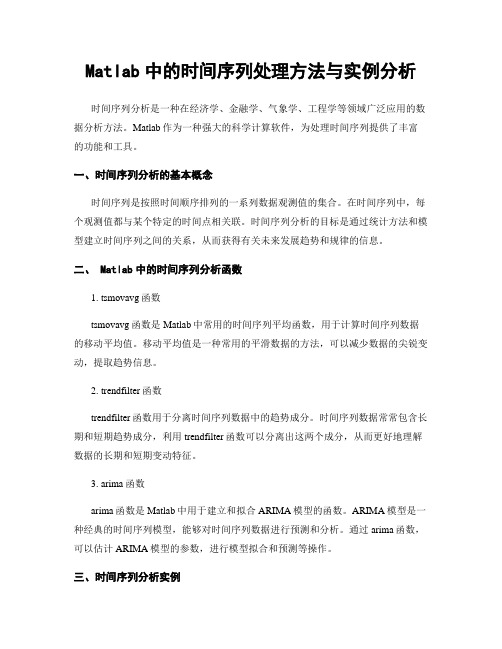
Matlab中的时间序列处理方法与实例分析时间序列分析是一种在经济学、金融学、气象学、工程学等领域广泛应用的数据分析方法。
Matlab作为一种强大的科学计算软件,为处理时间序列提供了丰富的功能和工具。
一、时间序列分析的基本概念时间序列是按照时间顺序排列的一系列数据观测值的集合。
在时间序列中,每个观测值都与某个特定的时间点相关联。
时间序列分析的目标是通过统计方法和模型建立时间序列之间的关系,从而获得有关未来发展趋势和规律的信息。
二、 Matlab中的时间序列分析函数1. tsmovavg函数tsmovavg函数是Matlab中常用的时间序列平均函数,用于计算时间序列数据的移动平均值。
移动平均值是一种常用的平滑数据的方法,可以减少数据的尖锐变动,提取趋势信息。
2. trendfilter函数trendfilter函数用于分离时间序列数据中的趋势成分。
时间序列数据常常包含长期和短期趋势成分,利用trendfilter函数可以分离出这两个成分,从而更好地理解数据的长期和短期变动特征。
3. arima函数arima函数是Matlab中用于建立和拟合ARIMA模型的函数。
ARIMA模型是一种经典的时间序列模型,能够对时间序列数据进行预测和分析。
通过arima函数,可以估计ARIMA模型的参数,进行模型拟合和预测等操作。
三、时间序列分析实例假设我们有一组销售数据,希望利用时间序列分析来预测未来销售情况。
首先,我们可以使用tsmovavg函数计算销售数据的三期移动平均值,以平滑数据,减少噪声干扰。
代码如下:sales = [50, 60, 70, 65, 80, 75, 90, 85, 100, 95];mov_avg = tsmovavg(sales, 's', 3);接下来,我们使用trendfilter函数分离销售数据的趋势成分。
趋势成分反映了销售数据的长期变动趋势。
代码如下:trend = trendfilter(sales);最后,我们可以使用arima函数建立ARIMA模型,并使用该模型对未来销售情况进行预测。
Matlab技术金融数据分析方法解读

Matlab技术金融数据分析方法解读随着金融市场的快速发展和技术的日益成熟,金融数据分析在决策和投资中扮演着重要的角色。
而Matlab作为一种常用的科学计算和数据分析工具,其在金融领域的应用日益广泛。
本文将深入探讨一些Matlab技术金融数据分析方法,并解读其应用。
一、时间序列分析时间序列分析是金融领域中常用的一种数据分析方法,它通过分析和预测时间上的依赖关系来揭示市场行为的规律。
在Matlab中,我们可以使用一系列函数和工具包来处理和分析时间序列数据。
首先,我们可以使用Matlab内置的时间序列对象(Timeseries)来存储和处理时间序列数据。
该对象可以方便地进行数据的索引和处理操作。
例如,我们可以用time和data分别表示时间和数据序列,并使用plot函数来绘制时间序列的图形。
其次,Matlab的金融工具箱中提供了许多常用的时间序列分析函数,例如自相关函数(autocorr)、偏自相关函数(parcorr)等,这些函数可以帮助我们分析和解释时间序列数据的结构和特征。
另外,Matlab还提供了一些经典的时间序列分析方法,例如移动平均(Moving Average)和自回归移动平均(Autoregressive Moving Average,简称ARMA)模型等。
这些模型可以通过拟合历史数据来预测未来的走势,并帮助我们进行风险评估和投资决策。
二、金融市场指标分析金融市场指标分析是金融数据分析的重要组成部分,它通过计算和分析各种市场指标来揭示市场的行为和趋势。
在Matlab中,我们可以使用一系列函数和工具包来计算和分析市场指标。
首先,我们可以使用Matlab内置的金融工具箱中的函数来计算和绘制各种常用的市场指标,例如移动平均线(Moving Average),相对强弱指数(Relative Strength Index,简称RSI)等。
这些指标可以帮助我们判断市场的趋势、分析市场的强弱和超买超卖情况。
Matlab中的金融数据分析技巧
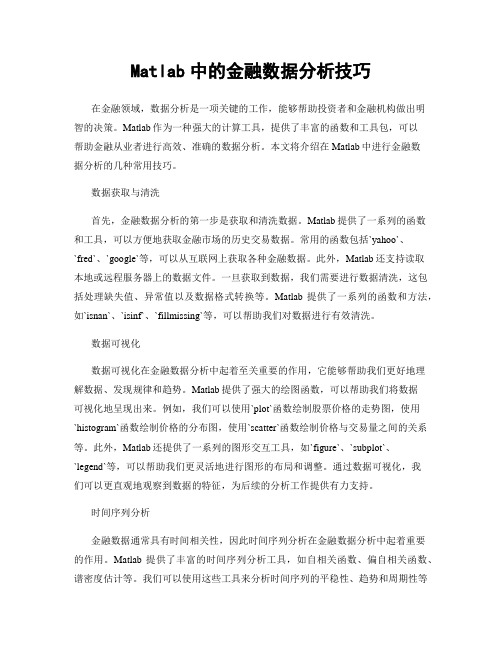
Matlab中的金融数据分析技巧在金融领域,数据分析是一项关键的工作,能够帮助投资者和金融机构做出明智的决策。
Matlab作为一种强大的计算工具,提供了丰富的函数和工具包,可以帮助金融从业者进行高效、准确的数据分析。
本文将介绍在Matlab中进行金融数据分析的几种常用技巧。
数据获取与清洗首先,金融数据分析的第一步是获取和清洗数据。
Matlab提供了一系列的函数和工具,可以方便地获取金融市场的历史交易数据。
常用的函数包括`yahoo`、`fred`、`google`等,可以从互联网上获取各种金融数据。
此外,Matlab还支持读取本地或远程服务器上的数据文件。
一旦获取到数据,我们需要进行数据清洗,这包括处理缺失值、异常值以及数据格式转换等。
Matlab提供了一系列的函数和方法,如`isnan`、`isinf`、`fillmissing`等,可以帮助我们对数据进行有效清洗。
数据可视化数据可视化在金融数据分析中起着至关重要的作用,它能够帮助我们更好地理解数据、发现规律和趋势。
Matlab提供了强大的绘图函数,可以帮助我们将数据可视化地呈现出来。
例如,我们可以使用`plot`函数绘制股票价格的走势图,使用`histogram`函数绘制价格的分布图,使用`scatter`函数绘制价格与交易量之间的关系等。
此外,Matlab还提供了一系列的图形交互工具,如`figure`、`subplot`、`legend`等,可以帮助我们更灵活地进行图形的布局和调整。
通过数据可视化,我们可以更直观地观察到数据的特征,为后续的分析工作提供有力支持。
时间序列分析金融数据通常具有时间相关性,因此时间序列分析在金融数据分析中起着重要的作用。
Matlab提供了丰富的时间序列分析工具,如自相关函数、偏自相关函数、谱密度估计等。
我们可以使用这些工具来分析时间序列的平稳性、趋势和周期性等特征。
此外,Matlab还提供了一系列的模型拟合函数,如AR模型、MA模型、ARMA模型等,可以帮助我们建立和评估时间序列模型。
如何利用Matlab进行时间序列分析

如何利用Matlab进行时间序列分析引言:时间序列分析是一种通过观察和分析时间序列数据来预测未来趋势和模式的方法。
Matlab是一种强大的数学计算工具,它提供了许多用于时间序列分析的函数和工具箱,使我们能够更轻松地进行数据分析和预测。
本文将介绍如何使用Matlab进行时间序列分析,并提供一些实用的技巧和方法。
一、数据导入和预处理1. 数据导入:首先,我们需要将时间序列数据导入Matlab中进行处理。
可以使用`readtable`函数将数据从文件中读取到一个Matlab表格中。
该函数支持多种文件格式,如CSV、Excel等。
读取数据后,可以使用`table2array`函数将表格转换为数组进行后续分析。
2. 数据可视化:将数据可视化是进行时间序列分析的重要步骤之一。
可以使用Matlab的绘图函数,如`plot`和`plotyy`,绘制不同的图形,如时间序列曲线、散点图、柱状图等。
通过可视化数据,我们可以更清晰地观察数据的趋势和规律。
3. 数据平滑:时间序列数据常常存在噪声和季节性等问题,为了减少这些干扰,我们可以对数据进行平滑处理。
Matlab提供了一些平滑函数,如`smoothdata`和`smooth`,可以通过设置不同的参数来实现数据平滑。
二、时间序列分析方法1. 自相关函数和偏自相关函数:自相关函数(ACF)和偏自相关函数(PACF)是时间序列分析中常用的工具。
可以使用Matlab中的`autocorr`和`parcorr`函数来计算ACF和PACF,并使用绘图函数将结果可视化。
通过观察ACF和PACF的图形,我们可以判断时间序列是否具有自相关性和偏自相关性,并初步确定合适的时间序列模型。
2. 模型识别和参数估计:在进行时间序列分析时,我们需要选择合适的时间序列模型,并估计其参数。
常用的时间序列模型包括AR模型、MA模型、ARMA模型和ARIMA模型等。
可以使用Matlab中的`ar`、`ma`、`arma`和`arima`函数来拟合相应的模型,并得到参数估计结果。
如何用Matlab进行时间序列分析

如何用Matlab进行时间序列分析一、简介时间序列分析是一种重要的数据分析方法,广泛应用于金融、经济、气象等领域。
Matlab作为一种功能强大的数值计算软件,提供了丰富的时间序列分析工具。
本文将以Matlab为工具,介绍如何进行时间序列分析。
二、数据预处理在进行时间序列分析前,首先需要对数据进行预处理。
其中,最常见的预处理步骤包括缺失值处理、数据平滑以及异常值处理。
1. 缺失值处理时间序列数据中常常存在缺失值,处理缺失值是时间序列分析的重要一环。
Matlab提供了多种处理缺失值的方法,包括插值法、删除法和代入法等。
具体方法选择要根据数据的性质和缺失值的分布情况来确定。
2. 数据平滑数据平滑是对时间序列进行趋势分析的一种方法。
Matlab提供了多种平滑方法,如移动平均法、指数平滑法和Loess平滑等。
根据数据的特点选择合适数学模型进行平滑处理,以减少噪声和异常值的影响,更好地揭示时间序列的趋势性。
3. 异常值处理时间序列中的异常值会对分析结果产生较大干扰,因此需要对其进行处理。
Matlab提供了多种方法,如箱线图检测法、3σ原则和灰色关联分析等。
根据具体情况选择合适的方法进行异常值检测和处理,以保证分析结果的可靠性。
三、时间序列建模时间序列建模是对时间序列数据进行建模处理,根据模型进行预测和分析。
常见的时间序列模型包括ARIMA模型、ARCH/GARCH模型和VAR模型等。
1. ARIMA模型ARIMA模型是一种常用的时间序列建模方法,可以用来对时间序列数据进行预测和分析。
Matlab提供了函数arima,可以方便地拟合ARIMA模型,得到模型的参数和拟合结果。
通过对模型的检验和诊断,可以评估模型的拟合效果和预测精度。
2. ARCH/GARCH模型ARCH/GARCH模型是用来描述时间序列波动性的经典模型。
Matlab提供了函数arch和garch,可以方便地进行ARCH/GARCH模型的估计和预测。
如何在Matlab中进行时间序列分析

如何在Matlab中进行时间序列分析时间序列分析是一种广泛应用在统计学、金融学、经济学等领域的分析方法。
而Matlab作为一种功能强大且易于操作的数学软件,被广泛应用于时间序列分析中。
本文将介绍如何在Matlab中进行时间序列分析的基本步骤以及常用的方法和技巧。
一、数据导入和处理要进行时间序列分析,首先需要将数据导入到Matlab中。
Matlab支持多种数据格式的导入,包括Excel表格、文本文件、数据库等。
可以利用`readtable`或`xlsread`等函数读取数据,并将其存储为Matlab的数据结构,如矩阵或表格。
在导入数据后,还需要对数据进行预处理。
这包括检查数据的完整性和准确性,处理缺失值或异常值等。
Matlab提供了一系列的函数和工具,如`isnan`、`fillmissing`等,可以帮助我们进行数据清洗和修复。
二、时间序列展示和描述统计在进行时间序列分析之前,通常需要先对数据进行可视化和描述统计,以了解数据的特征和模式。
为了展示时间序列的变化趋势,可以使用Matlab的绘图函数,如`plot`、`bar`等。
可以显示单个时间序列的变化情况,或者将多个时间序列进行比较。
除了可视化,还可以计算时间序列的描述统计,如均值、方差、峰度等。
Matlab提供了`mean`、`var`、`kurtosis`等函数,可以方便地进行计算。
三、平稳性检验和差分在时间序列分析中,平稳性是一个重要的概念。
平稳序列的统计特性不随时间变化,更容易建立和解释模型。
为了检验时间序列的平稳性,可以使用Matlab中的`adftest`或`kpss`等函数。
这些函数根据不同的平稳性检验方法,来确定时间序列是否平稳。
如果时间序列不平稳,可以采取差分的方法进行处理。
差分可以通过计算两个时间点之间的差异,将非平稳序列转化为平稳序列。
在Matlab中,可以使用`diff`函数来实现差分操作。
四、自相关和偏自相关分析自相关和偏自相关是分析时间序列之间关系的重要工具。
使用Matlab进行时间序列分析的方法

使用Matlab进行时间序列分析的方法时间序列分析是一种研究随时间变化的现象的方法。
在各个领域中,时间序列分析经常用于分析经济、金融、气象、交通等数据。
在本文中,我们将介绍使用Matlab进行时间序列分析的一些常用方法。
一、时间序列分析的基本概念和数据准备时间序列分析是根据一个或多个时间点上观测到的数值构成的数列来对未来或未来的数值进行预测和分析的一种技术方法。
在时间序列分析之前,我们首先需要对数据进行预处理和准备。
1. 数据读取和展示Matlab提供了多种读取数据的函数,例如xlsread、csvread等。
通过这些函数,我们可以将外部数据导入到Matlab工作环境中,并进行展示。
展示数据的常见方法是使用plot函数,该函数可以绘制时间序列的图形。
2. 数据平稳性检验在进行时间序列的分析之前,我们需要对数据的平稳性进行检验。
平稳性是指随时间变化,时间序列的均值和方差都不发生显著的变化。
常见的平稳性检验方法有ADF检验、KPSS检验等。
二、时间序列分析的方法在确定时间序列数据具有平稳性后,我们可以进行时间序列分析。
时间序列分析的方法主要包括时间序列模型、平滑方法、周期性分析、趋势分解等。
1. 时间序列模型时间序列模型是一种用来描述和预测时间序列的方法。
常见的时间序列模型有自回归移动平均模型(ARMA)、自回归积分滑动平均模型(ARIMA)、季节性自回归积分滑动平均模型(SARIMA)等。
使用Matlab中的arima函数可以方便地进行时间序列模型的建立和预测。
2. 平滑方法平滑方法是通过某种函数对时间序列数据进行平滑处理,以提取出数据的整体趋势和周期性成分。
常见的平滑方法有移动平均法、指数平滑法等。
3. 周期性分析周期性分析是对时间序列数据中存在的周期性成分进行分析和预测的方法。
常见的周期性分析方法有傅里叶分析、小波变换等。
在Matlab中,可以使用fft函数进行傅里叶分析,使用cwt函数进行小波变换。
Matlab技术时间序列分析方法解读

Matlab技术时间序列分析方法解读时间序列是指按照时间顺序排列的一组数据或观测值。
在很多领域,特别是金融、经济学、气象学等,我们经常需要对时间序列进行分析,以揭示其中的规律和趋势。
而Matlab作为一种强大的数学计算软件,提供了丰富的时间序列分析方法。
本文将对Matlab中的几种时间序列分析方法进行解读,包括自相关函数、谱分析、自回归模型等。
第一部分:自相关函数自相关函数(autocorrelation function)是时间序列分析中常用的方法之一,用于衡量一个时间序列数据与其在不同时间延迟下的自相关程度。
Matlab中提供了自相关函数的计算方法,可以通过绘制自相关函数图像来查看序列数据的自相关性。
在Matlab中,可以使用acf函数来计算自相关函数,其语法为:[r, lags] = autocorr(data)r为自相关函数的值,lags为时间延迟数。
通过绘制lags和r的图像,我们可以直观地观察到序列数据的自相关性。
第二部分:谱分析谱分析是一种时间序列分析的重要方法,用于研究信号在频域上的特性。
在Matlab中,可以使用periodogram函数来进行谱分析。
在进行谱分析之前,通常需要对时间序列数据进行预处理,以减少噪音的影响。
谱分析可以帮助我们了解时间序列中的周期性或周期性的特征。
通过绘制谱分析图,我们可以观察到时间序列在不同频率下的能量分布情况。
这对于揭示序列中的周期性规律以及对周期性变化进行预测非常有帮助。
第三部分:自回归模型自回归模型(autoregressive model)是一种常用的时间序列分析方法,用于预测未来一段时间内的序列数据。
在Matlab中,可以使用arima函数来建立自回归模型。
自回归模型的基本思想是将序列数据的当前值与过去的值之间建立数学关系,从而实现对未来值的预测。
在建立自回归模型之前,我们需要对时间序列数据进行平稳性检验,以确保模型的可靠性。
自回归模型可以通过AR(p)模型描述,其中p表示模型中的滞后项数。
Matlab中的金融时序数据分析与预测技术

Matlab中的金融时序数据分析与预测技术金融市场中的时序数据分析和预测一直是投资者和金融从业者关注的重点。
随着计算机技术的快速发展和数据量的急剧增加,利用计算机进行金融时序数据分析和预测已经成为必然选择。
Matlab作为一种强大的数学计算软件,在金融领域的应用显示出了许多优势。
它提供了丰富的数学和统计函数库,同时具备强大的数值计算和可视化功能。
本文将介绍和探讨Matlab中的金融时序数据分析与预测技术。
一、Matlab中的数据读取与处理在进行金融时序数据分析之前,首先需要将数据导入到Matlab中,并进行必要的数据清洗和处理。
Matlab提供了多种数据读取函数,可以直接读取各种常见的数据格式,如文本文件、Excel文件和数据库。
对于金融时序数据,常用的数据格式是CSV(逗号分隔值)文件,在Matlab 中可以使用`csvread`函数读取。
读取完成后,可以采用Matlab提供的数据处理函数,如数据缺失值处理、数据平滑和数据标准化等。
二、Matlab中的时间序列分析金融市场的数据通常是按时间顺序排列的,因此时间序列分析是金融数据分析的重要组成部分。
Matlab提供了丰富的时间序列分析函数和工具箱,可以进行时间序列数据的基本统计描述、自相关和偏自相关分析、平稳性检验以及时间序列模型拟合等。
Matlab提供了ARIMA模型(自回归移动平均模型)的函数,可以通过模型参数的估计和模型诊断,对时间序列数据进行建模和预测。
另外,Matlab还提供了GARCH模型(广义自回归条件异方差模型)的函数,用于分析和建模金融市场的波动性。
三、Matlab中的金融数据可视化金融时序数据的可视化是理解和分析数据的重要手段之一。
Matlab提供了丰富的数据可视化函数和工具箱,可以用于绘制线性图、柱状图、散点图、饼图以及热力图等。
对于时间序列数据,常用的可视化方法是绘制K线图。
Matlab提供了`candle`函数,可以绘制股票价格的K线图,并通过调整参数来显示不同的时间粒度和指标。
- 1、下载文档前请自行甄别文档内容的完整性,平台不提供额外的编辑、内容补充、找答案等附加服务。
- 2、"仅部分预览"的文档,不可在线预览部分如存在完整性等问题,可反馈申请退款(可完整预览的文档不适用该条件!)。
- 3、如文档侵犯您的权益,请联系客服反馈,我们会尽快为您处理(人工客服工作时间:9:00-18:30)。
egarch
Methods
1. estimate
fit = estimate(model,Y); 返回一个model [E,V] = infer(model,Y)
2. infer
residuals and conditional variances of a univariate ARIMA model fit to data Y. 3. forecast [Y,YMSE] = forecast(model,numPeriods) : responses for a univariate ARIMA model, and generates corresponding mean square errors, YMSE. 4. simulate
①moving average (MA), ②autoregressive (AR), ③mixed autoregressive and moving average (ARMA), ④integrated (ARIMA), ⑤multiplicative seasonal models.
Specify Conditional Mean Models Using arima
P136 to test for autocorrelation at multiple lags jointly
>>load Data_Overshort >>Y = Data; >>N = length(Y); >>[h,p,Qstat,crit] = lbqtest(Y,'Lags',[5,10,15]) h=1 1 1 significant autocorrelation
1. 趋势平稳:先回归,去掉趋势,在分析; 2. 差分平稳:确定差分的阶数(差分后平稳性); 3. 季节性平稳:差分的步数; 4. 混合平稳:滞后算子因式分解。 pdf257 pdf59 A = LagOp({1,-0.3,0.6},'Lags',[0,1,4])
趋势平稳
t = [1:200]'; trend = 0.5*t; model = arima('Constant',0,'MA',{1.4,0.8},'Variance',8); u = simulate(model,300,'numPaths',50); Yt = repmat(trend,1,50) + u(101:300,:);
例子:pdf124oxplot | qqplot | ksdensity | autocorr | parcorr | lbqtest | archtest
Choose ARMA Lags Using BIC pdf 312
Ljung-Box Q-Test
Unit Root Tests: pdf 163
Unit Root Tests: pdf 163
p122
a five-step process for identifying, selecting, and assessing conditional mean models (for discrete, univariate time series data). ARMA
金融时间序列分析
陆贵斌
2012年10月
基本思路 作为引入,先搞清楚时间序列; 分析时间序列的目的:挖掘背后的规律, 以利于预测未来;
内容
第1部分 前言 第2部分 时间序列分析基础
第3部分 matlab时序分析
第4部分 金融时间序列分析
第3部分 Matlab时间序列分析
Matlab时间序列分析工具箱 一.统计工具箱 Statistics toolbox
二.计量工具箱 Econometric toolbox
三.金融工具箱 Finance toolbox
3.1 统计工具箱 Statistics toolbox ① 单变量随机分布
② 单变量模拟抽样
③ 多变量随机分布
④ 数据拟合
单变量随机分布
>>disttool 演示各种随机分布图
t分布 与 Z分布
也可直接用程序,呈现随机分布 >>x = -5:0.1:5; >>y = tpdf(x,5); % t 分布 >>z = normpdf(x,0,1); % 标准正态分布 >>plot(x,y,'-',x,z,'-.')
0.4 0.35 0.3 0.25 0.2 0.15 0.1 0.05 0 -5
-4
-3
-2
-1
0
1
2
3
4
5
重复抽样
>>randtool
%可保存随机数
%后面可用
>>z1 = random('Normal',0,1,2,4) %2行4列 x1 = 1.1650 0.0751 -0.6965 0.0591 0.6268 0.3516 1.6961 1.7971
多变量随机分布
>>mu = [2 3]; >>SIGMA = [1 1.5; 1.5 3]; %协方差矩阵 >>r = mvnrnd(mu,SIGMA,100); %随机数对 >>plot(r(:,1),r(:,2),'+')
数据的随机拟合:单变量
dfittool
3.2 计量工具箱 Econometric toolbox
一、model
a model:对象(类似于结构变量) adequately describes your data. 基础 for:regression inference, forecasting, and Monte Carlo simulation. ① Specification tests: identify data generating process. ② Model comparisons the fit of competing models, with penalties for complexity. ③ Goodness-of-fit checks assess the in-sample adequacy, assumptions hold, out-of-sample forecast performance.
1. Establish the stationarity of your time series. ACF,PACF 2. Identify a (stationary) conditional mean model for your data. 3. Specify the model, and estimate the model parameters. 4. Conduct goodness-of-fit checks to ensure the model describes your data adequately. 5. use the model to forecast or generate Monte Carlo simulations
p207
A static conditional mean model: the ordinary linear regression model. A dynamic conditional mean model
arima class
model objects for stationary, or unit-root nonstationary linear time series models. includes
[Y,E] = simulate(model,numObs) :
sample paths and residuals from the ARIMA model, model.
1)Simulate 500 data points from the ARMA(2,1) model >>simModel = arima('AR',{0.5,0.3},'MA',0.2,'Constant',0,'Variance',0.1); >> rng(5); >>Y = simulate(simModel,500); 2)Specify an ARMA(2,1) model with no constant and unknown coefficients and variance. >>model = arima(2,0,1); >>model.Constant = 0 3)Fit the ARMA(2,1) model to Y. >>fit = estimate(model,Y)
arima(p,D,q)
(seasonal) ARIMA model p257 stationary ARMA model p283 >>MA模型
modelMA = arima('Constant',0,'MA',{0.8,0.5,-0.1}); impulse(modelMA,30) :响应值,2012a版出错
步骤1识别:决定模型的阶数,数据的动态特征
数据时间图,acf,pacf
步骤2估计:参数估计,OLS,极大似然估计; 步骤3检验:模型检验
过度拟合法:拟合一个更大模型,应该不显著; 残差诊断法:残差序列无线性关系,否则还有模 型没有反映出来的动态特征;(acf,pacf, Ljung-Box法)
